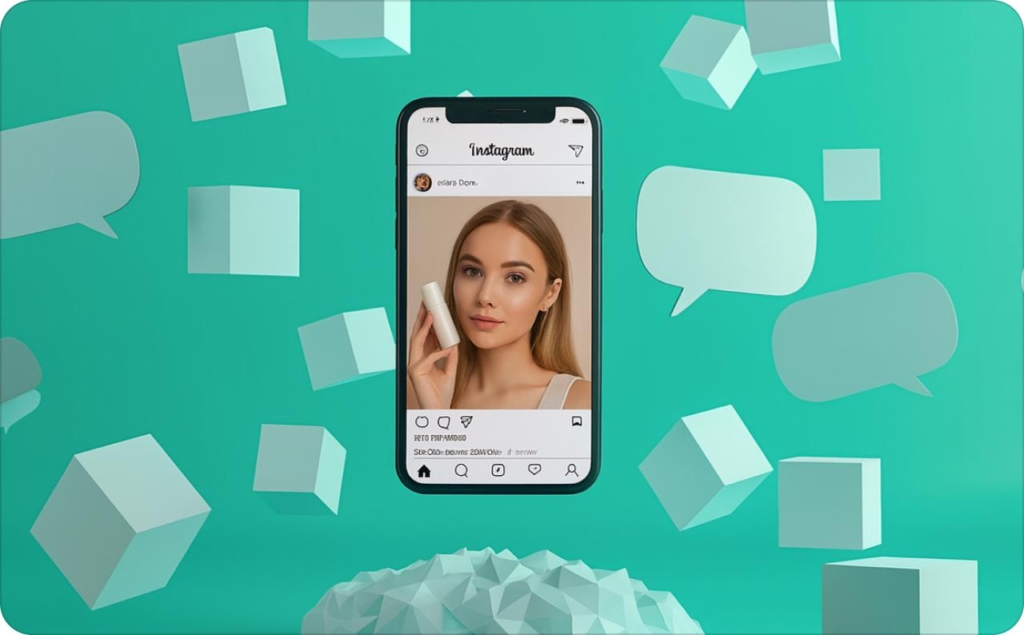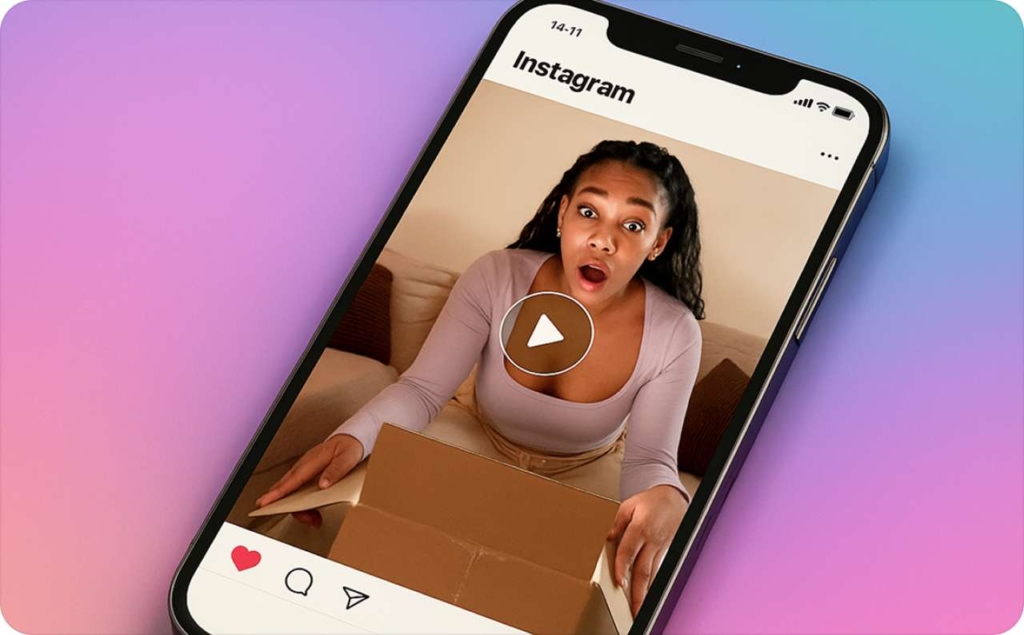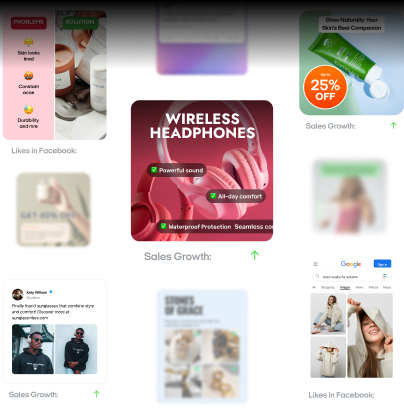Interactive ads: 6 key types & how to use them
If your display ads aren’t getting clicks, they’re basically invisible. People scroll fast these days, and static banners often blend into the background. That’s why interactive ads stand out.
They’re dynamic formats that respond to tapping, swiping, or hovering. Instead of watching an ad, your audience engages with it — whether it’s a mini-game, a quiz, an AR try-on, or a shoppable ad that lets them buy right away.
But are interactive ads really worth it? A 2024 Statista survey found that 31% of U.S. consumers buy from online ads at least every few months, with that number rising to 40% among those aged 55–64.
Interactive advertising can lead to double the click-through rates compared to static banners. That means more conversions, lower CAC, and stronger ROAS. You can also personalize each user’s path, making every touchpoint feel relevant and boosting brand recall.
You’ll see exactly what makes interactive ads different from static formats. You’ll also discover how they boost ROI by capturing audience data and cutting through banner fatigue.
You’ll learn which tools and best practices help you develop dynamic campaigns without headaches. Then, we’ll show you how to measure success with metrics like CTR, CAC, and ROAS, and offer tips on avoiding common pitfalls.

What are interactive ads?
If your ads only talk to people, they’re easy to ignore. Interactive ads are digital formats that respond to what users do in real time.
They let your audience tap, swipe, or even shop without leaving the ad. Static ads show the same content to everyone, but interactive ads adapt based on each person’s actions.
That means more personalized experiences. People can play a mobile game, shop in a video, or test a product in AR — all within the ad.
Interactive content can boost engagement compared to static ads. Forbes backs this up by saying it puts us in the driver’s seat and makes us feel like we’re the only driver on the road.
You don’t need a massive budget or deep coding knowledge to make this work. Rich media ad platforms and drag-and-drop tools simplify production. They also capture real-time analytics like click paths or watch time, so you can refine targeting and push ROI higher.
Where do they work?
Meta supports in-feed carousels and playable ads. TikTok favors UGC video ad types. Google’s Display Network serves interactive banners on countless sites.
This cross-platform reach is crucial. It helps you serve dynamic, user-focused campaigns to anyone, anywhere.
Interactive ads give viewers a reason to engage. Next, we’ll show you how these formats lift CTR, brand awareness, and revenue, so you can use them in your own campaigns.
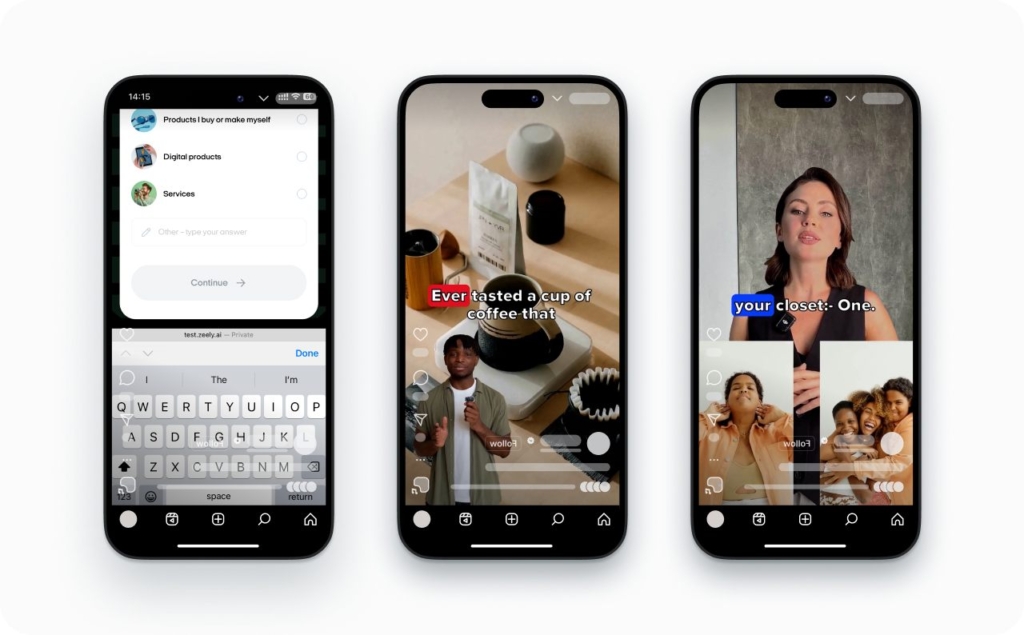
Benefits and advantages of interactive ads
If your ads aren’t pulling in clicks, they’re draining your budget. Interactive ads can change that. They boost engagement, drive conversions, and give you real-time insights — without demanding a giant budget or a big team.
Interactive advertising makes people active participants. They’re no longer just watching a banner. They’re tapping, swiping, and even playing inside the ad itself.
Many marketers see a jump in CTR and conversion rates in the first few days. That’s because interactive ads capture curiosity faster. They also stretch your spend further, delivering better returns on fewer impressions.
“Interactive content not only aims to stimulate a reaction…but marketers also want their audiences to share those reactions.”
That sharing creates a real conversation between consumers and brands, and it helps you cut through banner blindness.
Easy setup
You don’t need advanced coding. Rich media platforms and drag-and-drop tools keep production simple. Even if your audience isn’t tech-savvy, interactive ads feel natural because tapping and swiping are second nature for most people.
Every click or swipe fuels real-time analytics, so you’ll see what’s working at the moment. Many brands gain momentum fast, since you can tweak your ad performance to match user behavior right away.
Bottom line
Interactive ads don’t just get noticed — they hold attention. They inspire sharing, build loyalty, and deliver data-driven insights so you can optimize your strategy. If you want better ROI without ballooning costs, it’s time to go interactive.
Key benefits you’ll see
- Higher engagement: More clicks, swipes, and interactions
- Stronger conversions: Faster path to purchase
- Increased brand recall: Memorable, user-driven experiences
- Live analytics: Immediate feedback to optimize campaigns
- Lower CPA: Better returns with fewer impressions
Types and formats of interactive ads
If your interactive ads don’t match the right format, you’ll lose clicks and budget. Each format shines under certain conditions, goals, and platforms. Here’s a deeper look at each — and why it matters.
Playable ads
They’re like mini demos. People tap, swipe, or play to sample an app or game before committing. Many see 20% more installs because users feel confident trying the core feature first. Playable ads thrive on Meta, TikTok, or Google Display when mobile app installs or product testing is your aim.
Pro tip: Reveal the fun or critical feature right away. Let users experience a highlight in seconds.
Why it matters: Playable ads reduce user hesitation by letting them “try before they buy.” This hands-on preview builds trust, shortens the decision cycle, and pushes engaged users further down the funnel.
Shoppable ads
They make your ad a mini store. Shoppers browse or buy on the spot, cutting extra steps. Many eCommerce brands see 30% higher conversion by letting customers tap and purchase inside the feed. Instagram, Facebook, and TikTok excel for fast sales.
Tip: Keep the path from “want” to “buy” under three taps. Fewer steps mean less friction.
Why it matters: Shoppable ads speed up the buying journey. They combine discovery and checkout in one seamless flow, boosting impulse buys and preventing cart abandonment.
AR & VR ads
They create an immersive environment like a virtual showroom. AR ads let people “try on” glasses or place furniture in their living room. VR ads offer 360° brand worlds for deeper exploration. IKEA famously uses AR, boosting dwell time 2–3x over static visuals.
Pro tip: Test on multiple devices and OS versions to avoid compatibility woes.
Why it matters: AR & VR ads engage users on a sensory level. By letting them experience products in a realistic setting, you raise confidence, enhance brand recall, and stand out in crowded feeds.
Interactive video ads
They run like choose-your-own-adventure stories within a video. People click, poll, or shape the narrative. Some advertisers gather real-time feedback, like color preferences, often seeing double the engagement time. YouTube, Instagram Stories, or CTV host these seamlessly.
Tip: Place clickable elements early. Many viewers drop off by the midpoint.
Why it matters: Interactive video transforms passive watchers into active participants. That heightened engagement gives you richer data, stronger recall, and the chance to tailor experiences on the fly.
Interactive banner ads
They update classic banners with hover, scroll, or click responses. You might add polls, sliders, or hotspots that reveal pricing. IBM uses interactive banners on tech blogs for B2B leads. They’re great for retargeting or lead capture because they catch curious readers right in research mode.
Pro tip: Use obvious cues like “hover to see details” or “click to compare.”
Why it matters: Interactive banners add life to an otherwise static ad slot. With the right prompts, you can get quick signups or pique interest, all without interrupting the user’s browsing flow.
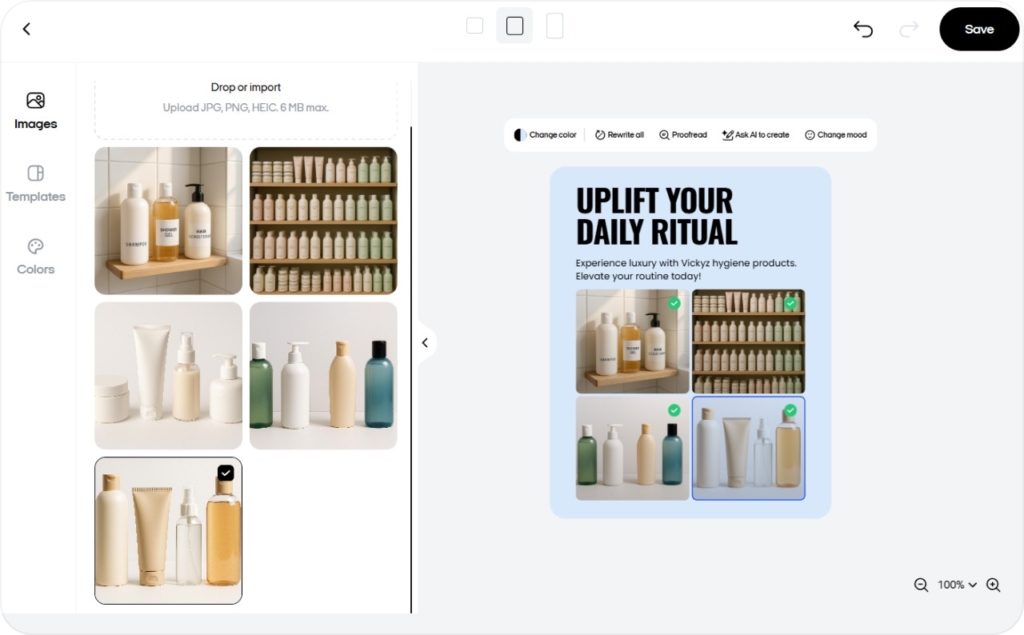
Emerging formats
They go beyond phones and desktops. Print-to-digital ads use QR codes in magazines or flyers, linking to AR experiences or instant demos. Connected TV ads integrate remote-friendly buttons so viewers can shop from their couch. As streaming and interactive print evolve, these formats gain serious momentum.
Tip: Make sure QR codes and remote prompts are large and intuitive. If they’re hidden or awkward, users won’t bother.
Why it matters: Emerging formats expand interactive advertising into offline or streaming spaces. They capitalize on curiosity, bridging real-world situations with digital experiences — and reach audiences where traditional ads can’t.
Choosing the right format
Playable excels at app installs or quick demos. Shoppable drives fast eCommerce sales. AR & VR create immersive brand-building and product trials. Interactive video fosters two-way storytelling, while interactive banners nail retargeting or lead capture.
Build a chart comparing each format’s pros, cons, and KPIs if you need a structured view. Or check out our interactive ad creatives guide for templates and real-world examples.
When you match each format to your goals, you’ll see more clicks, conversions, and brand engagement — plus fewer wasted impressions. It’s about pairing the right user experience with the outcomes you need.
Pros and cons: Evaluating interactive ads
Interactive ads can bring amazing results or drain your budget if you’re unprepared. They’re perfect for eCommerce, mobile app installs, or B2B lead gen — especially if your audience is tech-savvy and you want higher user engagement. But before you dive in, you should know the trade-offs.
The pros: Why interactive ads shine
You see higher engagement fast. People tap, swipe, or play inside the ad, boosting dwell time and conversion rates. You also get real-time analytics, so you see what’s working now — no waiting.
They’re also memorable. Because users help shape the experience, brand recall often jumps 2-3x compared to static ads. HubSpot explains why: “Delighting your audience is the key to engaging it — that’s why tactics like online quizzes, personalized content, and interactive AI video ads are so helpful. It gives audiences a unique experience that makes interacting with your business fun.”
The payoff can justify bigger production costs. Interactive video ads may cost 2–4x more than static banners, but they often deliver 2-3x more engagement, pushing your ROI higher.
What makes them succeed? Start with a clear CTA, fast load speeds, and mobile-ready design. Offer immediate, fun ways for users to interact, and remove friction wherever possible.
Is it right for you?
Use interactive ads if:
- You can handle extra production costs
- Your audience is mobile-friendly or game-ready
- You have time to test and optimize for richer data insights
Skip or wait if:
- You’re on a razor-thin budget
- Your audience relies on older devices or limited tech
- You’re not ready to manage privacy compliance or glitch fixes
Next steps
If you want a fun, memorable way to reach users — and you’re ready for technical and creative demands — interactive advertising can pay off big. In our next section, we’ll show you how to keep costs in check, squash tech glitches, and plan for user privacy — so your campaign runs smoothly right from the start.
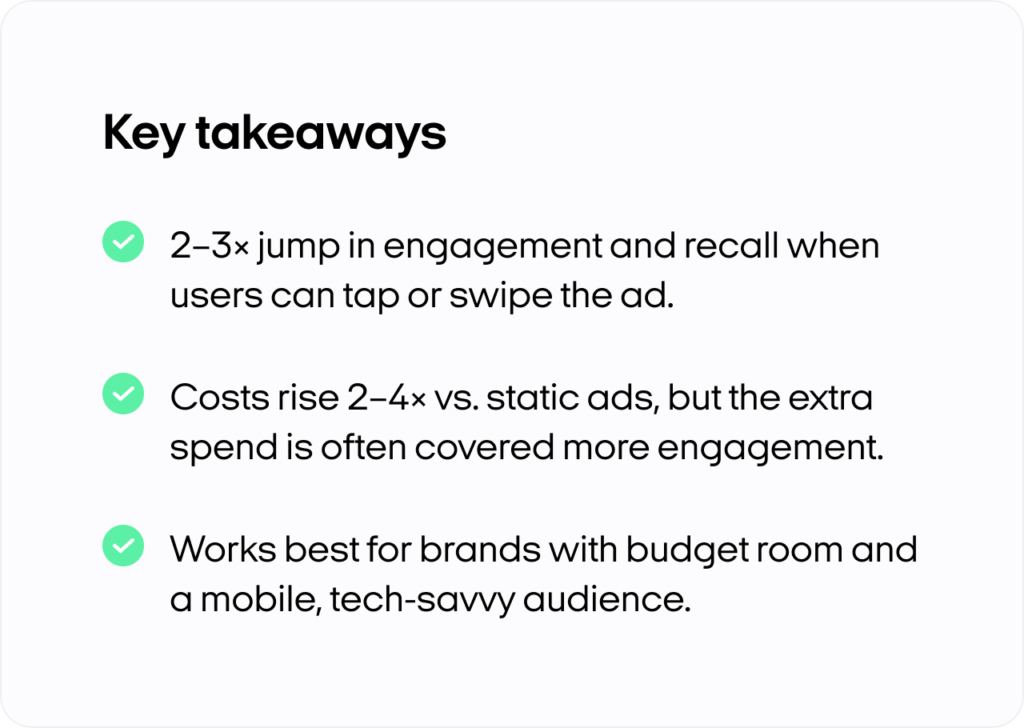
Best practices for creating effective interactive ad campaigns
How do you design interactive ads that actually convert? Start with a clear plan, test rapidly, and stay agile with real feedback.
1. Set clear goals
If your ad doesn’t convert, it’s rarely the format. Focus on a single objective, like product sales, email captures, or app installs, then plan a short timeline: 3–5 days for design, testing within a week.
2. Focus on one core action
Keep your AI ad creative strategy simple. Whether it’s a quiz, product slider, or demo, guide users toward one clear CTA so they aren’t overwhelmed.
3. Build modular and test fast
A/B testing is crucial. Try new headlines, visuals, or interactive elements, then track CTR, engagement time, and conversion rate to see what works and pivot quickly.
4. Listen to real user feedback
Watch scroll data for interaction depth or drop-off points. Tweak each week, not each quarter, because campaign optimization is a constant process.
5. Customize for each platform, then scale
Your TikTok audience behaves differently than those on YouTube or OTT. Adapt your format, keep messaging consistent, and scale once you spot a winning concept.
Common mistakes to avoid
Resist adding too many clickable elements or slow-loading screens. Don’t skip load speed checks, privacy disclosures, or a clear CTA. If you’re a small team, start with one simple format and scale as you learn.
Final step: Treat your ads like living campaigns
They should evolve with user data. Strategize, launch, test, refine, and repeat. That way, you’ll keep costs in check, adapt to change fast, and give your audience an interactive experience that truly resonates.
Conclusion and actionable next steps
If you want to launch a successful interactive ad campaign, start with a clear goal and test early. Adapt to each platform’s user flow, and you’ll move from concept to measurable ROI in no time.
High-performing campaigns revolve around a single objective — like clicks, signups, or sales. They rely on clean, mobile-friendly design, fast load speeds, and weekly A/B tests guided by real-time metrics.
Keep your format simple and friction-free. If your budget is tight, focus on one interactive element, like a quiz or shoppable carousel, then expand as you learn.
Hone in on one goal, such as eCommerce sales or app installs, and choose a format that matches your audience’s habits. Sketch a mobile-first concept, then build a test version using easy tools like Zeely AI.
Track key performance metrics — CTR, time on ad, conversions — over five to seven days. If you miss benchmarks, refine underperforming parts before you scale the winners to other audiences or platforms.
If you’re new, try a single Instagram Story quiz and test one message at a time. Turn your plan into a short 1-pager or slide deck so your team stays aligned.
What’s Next in Interactive Advertising? It’s evolving fast. Over half of marketers plan to focus on interactive video by 2025, thanks to AI-powered design and predictive testing. As attention spans shrink, an immersive, two-way experience will help your ads stand out more than ever.
Don’t wait for perfection. Launch your campaign, track your data, and iterate quickly. That’s how you turn a single test into a data-driven success story.
Also recommended
